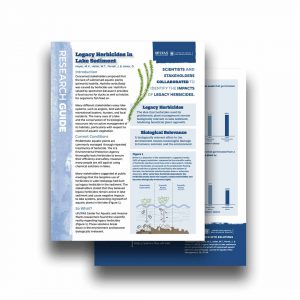Located in Highlands County, Florida, Lake Istokpoga is the state’s fifth-largest lake (approximately 27,000 acres). Many stakeholders use this lake; from anglers and boaters to birdwatchers and hunters, including the local ecotourism industry and lake residents. In recent years, Lake Istokpoga has not seen submersed aquatic vegetation (SAV) growth and stakeholders have grown increasingly concerned with what has caused underwater plants to stop growing in the lake.
Stakeholders believe that historical herbicide treatments caused this negative impact on the lake’s system. In this study, UF/IFAS Center for Aquatic and Invasive Plants (CAIP) professor and director Jay Ferrell, alongside LAKEWATCH director Mark Hoyer, CAIP professor emeritus William Haller, and former CAIP biologist Dean Jones, collaborated with stakeholders to investigate this phenomenon – together.
So What?
UF/IFAS researchers found that the stakeholders’ belief of negative herbicide impacts on lake systems and SAV growth was incorrect. Results from sediment samples and growing trials indicate that historical herbicide applications are not inhibiting plant growth.
As with many lakes, the variety of stakeholders and the conservation of the biological resources on Lake Istokpoga rely on active management efforts that oftentimes use herbicide solutions. The U.S. Environmental Protection Agency has a rigorous testing and registration process that ensures aquatic herbicides are efficient and safe.
To read more about the experiment details, check out the research guide.
This research guide highlights:
- Lake Istokpoga stakeholders have grown increasingly concerned with the lack of SAV in the water. These users believe that historical herbicide treatments have caused this disruption in the system.
- Scientists and stakeholders collaborated in this study to identify the impacts of legacy herbicides in lake sediment (specifically with sensitive tomato plants and a common invasive plant, Hydrilla).
- Both plants grew well in the Lake Istokpoga sediment samples and the chemical analysis did not find biologically-relevant levels of herbicide concentrations (see the journal article or research guide for more details). These results indicate that aquatic plant management with herbicide solutions does not impact potential SAV plant growth.
What is a Research Guide?
The UF/IFAS Center for Aquatic and Invasive Plants (CAIP) is a nationally and internationally recognized multidisciplinary research, teaching, and extension unit known for having the most relevant information on invasive plant management. This one-of-a-kind Center focuses on developing and disseminating strategies for addressing the impact of invasive plants.
In an effort to share their findings, CAIP researchers and the communications team collaborate to translate scientific journal articles into simple, easy-to-understand research guides. These one-page research guides are simplified summaries about research projects happening at the Center. They are created to assist plant industry professionals and the public understand new scientific information quickly and easily.
Questions or comments can be sent to the UF/IFAS CAIP communications manager at caip@ifas.ufl.edu. Follow UF/IFAS CAIP on Instagram, Facebook, and Twitter. Subscribe for more blogs like this one.
UF/IFAS Center for Aquatic and Invasive Plants. Turning Science Into Solutions.
Did you find this post helpful? Click the heart below!
 2
2
